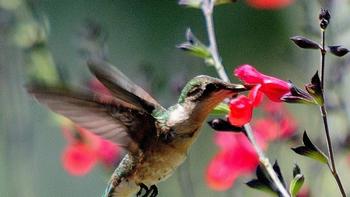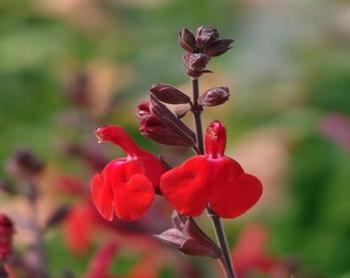Summer 2023
A salvia for every garden

- Depending on the species, salvias bloom from late spring through fall.
- Salvias are available in shades of blue, violet, red, pink, and white.
- Many salvias have interesting and unusual foliage, ranging in color from pale gray to bright green, making them a good addition to the garden even when they are not in bloom.
- Salvias grow from 18 inches tall to 5 feet or more, so there is a salvia for almost any spot in your garden.
- Because they are drought tolerant once established, salvias are a good choice for water-wise gardening.
- While salvias generally appreciate sun, some will tolerate partial shade, or even benefit from it in warmer gardens.
- Salvias have tubular flowers that attract pollinators such as hummingbirds, butterflies, and bees.
- Many varieties of salvia are deer-resistant!
Cultivation: Salvias are generally easy-maintenance plants that can be mainstays in a water-wise garden. Because they are found in habitats around the world, there isn’t one set of rules concerning cultural practices that can be applied to all salvias. They can suffer from common plant maladies such as fungal diseases and infestations of aphids or thrips, and some species can fall prey to slugs and snails. But two general and practical guidelines to keep your salvias happy and healthy are to plant them in fast-draining soil and to provide occasional top dressings of compost. California native salvias do not require compost or other soil amendments.
Watering: Salvias are best watered infrequently, slowly, and deeply. This way the plant’s roots are encouraged to travel outward and downward for water, resulting in stronger root systems. Avoid overhead watering. Most salvias are drought tolerant once established (but water regularly the first year). They do not need excessive summer irrigation. Some native California species of salvia (S. Clevelandii, or Cleveland sage, for example) prefer little or no irrigation once established.
Pruning salvias: Deadheading (removing the faded blooms) is a basic pruning practice that improves the health and appearance of any salvia and can be done as needed. Beyond that, pruning for healthy plant growth and good bloom depends on the type of salvia you have.
- Some salvias are rosette types, such as hummingbird sage (spathacea). These have erect flower stems above low mounds of foliage. During bloom time, completely removing any flowering stems after they are spent keeps the plant neat and will encourage it to flower again. In fall, when growth stops, remaining flower stems should be cut close to the ground. Pruning in this manner will strengthen the plant’s roots for the next growing season.
- Woody salvias, such as Autumn sages ( greggii species) and Cleveland sage (S. Clevelandii), can become shrub-like. During the growing season, removing spent blooms will stimulate new growth and flowering. In fall, clean up after the last bloom by cutting the spent stems to 5-6 inches above ground to prepare the plant for the next growing season. If you have frost in your area, wait until after the first frost. Some of these salvias can grow to be up to 6 or more feet tall and 4 feet wide, and pruning these shrubby salvias to remove old wood and crossed branches can be done throughout the growing season. Woody salvias can also be pruned to control height and width, to maintain an attractive appearance, and to encourage new growth.
- Some salvias are soft-stemmed deciduous sages, such as Mexican bush sage ( leucantha), and have no woody growth. During the growing season, unsightly stems that have finished blooming can be cut to the ground. When the plant's appearance becomes messy, trimming these sages to 6-12 inches above the ground should stimulate new growth and flowering. In the late fall/early winter, completely prune the spent stems close to the ground (3-4 inches). This severe pruning controls pests over the winter and gives you a clean start in the spring.
Some salvias to try:



